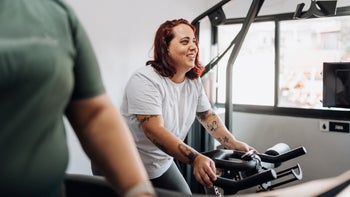
7 Science-Backed Benefits of Lunges
Key takeaways:
Lunges use large lower-body muscles, including the glutes, hamstrings, and quadriceps.
This strength-building move can help correct muscle imbalances, increase flexibility, and boost metabolism.
Forward lunges are the most common style of this exercise. But there are numerous variations to allow you to adapt lunges to suit your fitness level.

Ask any personal trainer for a lower-body workout, and chances are they'll recommend lunges. The lunge has become a go-to movement for trainers, athletes, and gym patrons alike. People love the exercise because of its versatility and low barrier to entry. In other words, if you can walk and run without pain, you can do a lunge. And because they engage multiple muscle groups, lunges offer many benefits to those who do them consistently.
What are the benefits of lunges?
Think of a lunge like a hammer: It's an essential, effective tool in your strength-training toolbox. Lunges use your bodyweight to activate several major muscle groups. And they can have many benefits.
1. Lunges strengthen lower-body muscles
Lunges are a compound exercise. This means they work multiple muscle groups and joints, unlike isolation movements like calf raises or bicep curls, which focus on one area at a time.
Save over 40% on Qsymia with GoodRx
Discover the once daily Qsymia for weight management. Qsymia is for adults and children 12-17 in combination with a healthy diet and regular exercise.

A complete fitness routine should include both compound and isolation exercises. But compound exercises give you the most bang for your buck. They engage more muscles and help you burn calories, making your workouts more efficient. One small study also found that compound exercises increase muscle strength and aerobic fitness better than isolation exercises.
Lunges target and strengthen some of the largest lower-body muscles, including:
Glutes or butt muscles
Quadriceps, at the front of the thigh
Hamstrings, at the back of the thigh
Calves
2. Lunges improve your balance
While a lunge primarily activates the lower body, it also uses core and stabilizer muscles. These include the hip flexors and abdominals. You have to engage your core to stay steady on your feet as you lunge. A strong, stable core has been shown to improve lower-limb function and balance, which may prevent falls and other injuries. That's not surprising, considering that the core is the center of all movement.
3. Lunges increase your flexibility
Sitting for long periods can make your hip flexor muscles shorter and tighter over time. Luckily, lunges can combat this muscle tension and weakness. This benefit comes from the range of motion involved in a lunge. When you lunge forward, backward, or to the side, you stretch your hip flexors, including the psoas muscle. Stretching is one of the best ways to increase your flexibility. So practicing lunges may increase hip flexibility and mobility.
4. Lunges can enhance your functional fitness and athletic performance
If it sounds like lunges fall into many exercise categories, it's because they do. The move is also a functional fitness exercise that helps improve everyday function by mimicking movements like kneeling, walking, and running. Adding lunges to your fitness plan may improve your functional strength, allowing you to move more efficiently in your daily life. And improved functional strength and mobility can also lead to improvements in your athletic performance.
Read more like this
Explore these related articles, suggested for readers like you.
5. Lunges help correct muscle imbalances
A muscle imbalance is exactly what it sounds like: a lack of balance between muscle groups. That happens when a particular group of muscles is stronger, weaker, looser, or tighter than muscles that pull in the opposite direction. For example, if you overtrain the biceps on the front of your arm, it could make the triceps on the back of your arm weak.
Everything from inactivity to overuse can cause muscle imbalances. These imbalances can lead to pain, injuries, and limited mobility.
Fortunately, lunges can help correct some of these muscle imbalances. They are a type of unilateral exercise that works one leg at a time, allowing you to make sure you work both sides equally. This can prevent imbalances in your hips, glutes, quads, and hamstrings. This explains why lunges may help prevent or rehabilitate ACL injuries and other musculoskeletal problems. Just make sure to do the same number of reps and sets on both legs.
6. Lunges may boost your metabolism
Metabolism is the body's ability to convert food into the energy it needs to function. Several factors –– including genetics and age –– determine how fast or slow your metabolism is. So you can't supercharge your metabolism overnight.
But you can make healthy lifestyle choices to give your metabolism a little boost. For example, resistance exercises like lunges build lean muscle mass, which may increase your metabolism. That's because muscle burns more calories than fat, even at rest.
Remember that doing lunges and other resistance exercises consistently is critical for building and maintaining muscle. If you want to make significant strength-training gains, you’ll eventually have to start using weights when you do lunges.
7. Lunges are convenient and accessible
Lunges are an accessible way for people of all fitness levels to start strength training. You can perfect this equipment-free move and slowly advance to more challenging versions. And you can get started at home, in the gym, or even at work during your lunch break.
How do you do a lunge?
The forward lunge is a simple, fundamental movement. These step-by-step instructions will help you learn important techniques for proper form.
Stand tall with your feet hip-width apart and your hands resting on your hips.
Engage your core, then step forward with your right foot, placing it about 2 to 3 feet in front of your left root.
Shifting your weight to your front leg, bend your knees, lowering your body until your back knee is a few inches off the floor. Your front knee should be bent at a 90-degree angle, with your thigh parallel to the floor.
Press through your front foot to return to the standing lunge position. Squeeze your glutes on the way up, too.
Step your right foot back, returning to the starting position.
Repeat on the other side.
If you want to check your form, try practicing lunges in front of a full-body mirror. Keep an eye on your front knee while you’re in the lunge position (step 3). You want it to be slightly behind or barely hovering over your toe.
What are the different types of lunges?
There are numerous lunge variations, some of which are more or less challenging than a standard forward lunge. You can adjust the components of a lunge –– like the direction, pace, and resistance (with added weights).
Side lunge
Side or lateral lunges work the same muscles as a forward lunge along with your abductors (outer thigh muscles) and adductors (inner thigh muscles). Many people find side lunges easier than forward lunges. So they're a good place to start if you're a beginner.
Stand tall with your feet hip-width apart. You can place your hands on your hips or hold them in front of your chest.
Engage your core and step your right foot out to the side. Keep your toes pointing forward and your feet flat on the floor.
Shift your weight to the right as you bend your right knee to a 90-degree angle. Keep your hips back with your left leg extended while you hold the lunge.
Push through your right foot to return to the starting position.
Repeat on the other side.
Twist lunge
Try a twist lunge to increase the challenge for your core muscles.
Stand tall with your feet hip-width apart and hold your hands together in front of your chest.
Contract your core as you step forward with your right foot.
Bend your knees to lower your body into a basic forward lunge.
Twist your upper body to the right, keeping your core engaged. Make sure your legs stay in the proper lunge position and try not to rotate too far. Doing so can cause injury.
Rotate your body back to center in a slow, controlled movement.
Press through your right foot to return to the starting position.
Repeat on the other side.
Walking lunge
You can increase your lunging pace and range of motion with walking lunges.
Stand upright with your feet hip-width apart, your hands on your hips, and your core engaged.
Step your right foot 2 to 3 feet in front of you.
Inhale as you bend your knees and lower into a forward lunge, with your front knee at a 90-degree angle and your back knee a few inches off the floor.
Exhale as you push off from your right foot to return to standing.
Repeat steps 2–4 with your left leg, remembering to breathe and focus on your form.
Keep alternating between your left and right sides, doing one lunge after another so that you "walk" forward.
The bottom line
Lunges are an effective, foundational exercise for people of different fitness levels. They help you build muscle, correct muscle imbalances, and avoid injury. There are numerous variations of lunges, making them suitable for beginners and advanced exercisers alike. You can adjust the pace, direction, and intensity of your lunges to meet your particular needs. But it's best to master the forward lunge before trying more complex versions.
Why trust our experts?



References
American Council on Exercise. (n.d.). Forward lunge.
American Council on Exercise. (n.d.). Side lunge.
Ashmore, A. (2018). The benefits of unilateral training. American Council on Exercise.
Begalle, R. L., et al. (2012). Quadriceps and hamstrings coactivation during common therapeutic exercises. Journal of Athletic Training.
Franklin, A. (2016). 5 Lunge Variations You Need to Try. American Council on Exercise.
Jonhagen, S., et al. (2009). Muscle activation and length changes during two lunge exercises: Implications for rehabilitation. Scandinavian Journal of Medicine & Science in Sports.
Kang, K. (2015). Effects of core muscle stability training on the weight distribution and stability of the elderly. Journal of Physical Therapy Science.
Keogh, J., et al. (1999). Lower-body resistance training: Increasing functional performance with lunges. Strength and Conditioning Journal.
Mahaffey, K. (n.d.). Functional training: Compound workouts for fitness. NASM.
Muyor, J. M., et al. (2020). Electromyographic activity in the gluteus medius, gluteus maximus, biceps femoris, vastus lateralis, vastus medialis and rectus femoris during the monopodal squat, forward lunge and lateral step-up exercises. PLoS One.
Nakamura, K., et al. (2014). Effects of active individual muscle stretching on muscle function. Journal of Physical Therapy Science.
Neto, W. K., et al. (2020). Gluteus maximus activation during common strength and hypertrophy exercises: A systematic review. Journal of Sports Science & Medicine.
Paoli, A., et al. (2017). Resistance training with single vs. multi-joint exercises at equal total load volume: Effects on body composition, cardiorespiratory fitness, and muscle strength. Frontiers in Psychology.
Peterson, M. D., et al. (2011). Influence of resistance exercise on lean body mass in aging adults: A meta-analysis. Medicine and Science in Sports & Exercise.
Sabido, R., et al. (2017). Effects of adding a weekly eccentric-overload training session on strength and athletic performance in team-handball players. European Journal of Sport Science.
Sasaki, S., et al. (2019). Core-muscle training and neuromuscular control of the lower limb and trunk. Journal of Athletic Training.



























